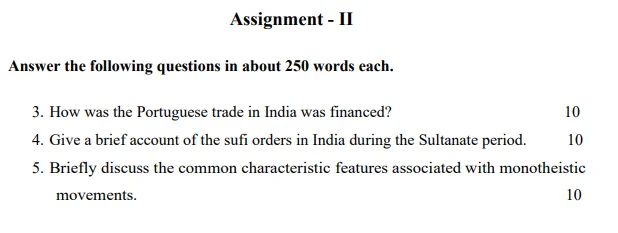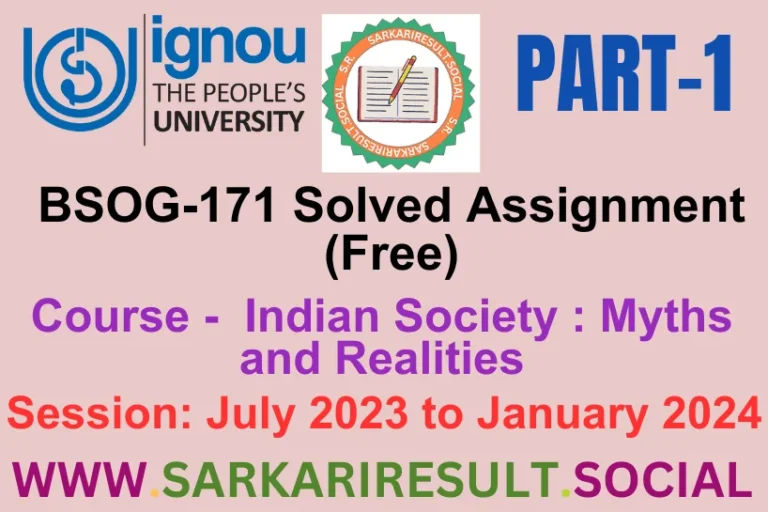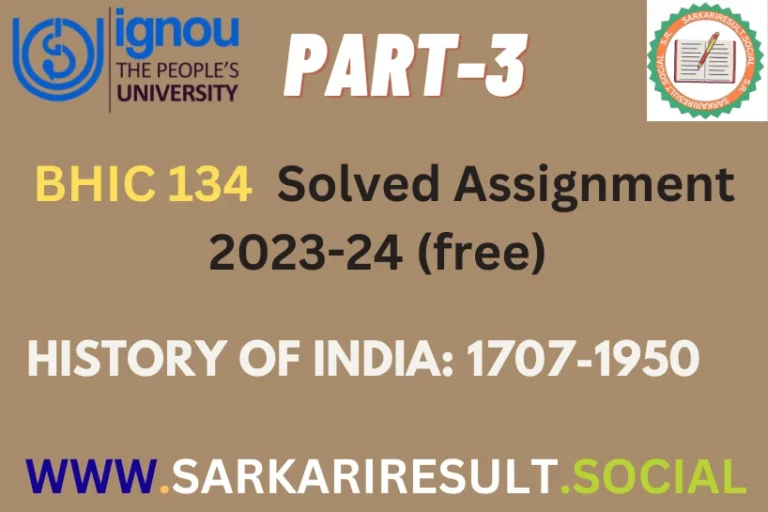BHIC 133 IGNOU Solved Assignment 2023-24 (free) Part -2

BHIC 133 IGNOU Solved Assignment 2023-24 (free) Part -2
Enhance your historical insights with BHIC 133 IGNOU Solved Assignment 2023-24 (free) Part -2, presenting three thought-provoking questions, each demanding a concise 250-word response. Our meticulous solutions maintain academic rigor while exploring within specified word limits. Deepen your understanding of historical perspectives, meet the criteria effectively, and excel in your academic journey. Access BHIC-133 IGNOU Assignment 2 solutions to broaden your historical knowledge and refine your analytical approach to scholarly investigations.

3. How was the Portuguese trade in India was financed?
Ans. The Portuguese trade in India was financed through various means, including partnerships, investments, and support from the Portuguese crown, as well as through commercial and financial activities conducted in India and Europe.
Also Read This: BHIC 133 IGNOU Solved Assignment 2023-24 (free) Part -1
Financing Methods:
1. Crown Support: The Portuguese Crown provided initial capital, ships, and resources for exploratory voyages to India. King Manuel I sponsored Vasco da Gama’s expedition to find a direct sea route to India in 1498.
2. Trade Partnerships: Portuguese traders formed partnerships or consortia with investors, merchants, and financiers to fund voyages and trading ventures. They pooled resources and shared profits and risks.
Also Read This: BHIC 131 IGNOU Solved Assignment 2023-24 (free) Part -1
3. Merchant Capital: Portuguese merchants contributed their own capital for trade expeditions, using personal finances or resources obtained from previous successful ventures.
4. Loans and Credit: Financial institutions in Europe provided loans and credit to Portuguese merchants for trade in India. Loans were secured against future profits and commercial gains.
5. Capturing Wealth: The Portuguese engaged in military conquests, piracy, and seizing ships carrying valuable goods, which became a source of wealth and financing for their trade endeavors in India.
Also Read This: BHIC 131 IGNOU Solved Assignment 2023-24 (free) Part -2
6. Trade Profits: Successful trade ventures yielded profits in the form of valuable commodities like spices, textiles, precious metals, and gemstones, which were sold in Europe to finance further expeditions.
7. Taxation and Levies: The Portuguese established trading posts and forts along the Indian coastline, imposing taxes, levies, and duties on goods traded, contributing to their revenue and financing trade activities.
Impact and Influence:
The Portuguese trade in India, financed through these diverse methods, had far-reaching consequences. It transformed global trade dynamics by connecting Europe directly to the lucrative spice trade of the Indian Ocean, leading to the establishment of a Portuguese empire in India and significant European presence in the region. The financial strategies employed by the Portuguese helped sustain their trade operations, resulting in both economic gains and geopolitical influence in India and beyond.
Also Read This: BHIC 131 IGNOU Solved Assignment 2023-24 (free) Part -3
4. Give a brief account of the sufi orders in India during the Sultanate period.
Ans. During the Sultanate period in India (1206-1526), Sufism, the mystical dimension of Islam, thrived and spread through various Sufi orders or tariqas, contributing to the cultural, social, and spiritual fabric of the subcontinent.
Sufi Orders:
1. Chishti Order: Introduced by Khwaja Moinuddin Chishti, the Chishti order emphasized love, simplicity, and spiritual communion with God. Its centers in Ajmer and Delhi attracted people from diverse backgrounds and stressed on humanitarianism and tolerance.
Also Read This: BHIC 132 IGNOU Solved Assignment 2023-24 (free) Part -1
2. Suhrawardi Order: Founded by Sufi saint Shaikh Shihabuddin Suhrawardi, this order focused on asceticism, spiritual discipline, and adherence to Islamic law. It emphasized the importance of self-purification and inner knowledge.
3. Qadiri Order: Initiated by Abdul Qadir Jilani, this order advocated direct spiritual experiences and individual transformation. It attracted followers due to its emphasis on love, devotion, and the path of renunciation.
4. Naqshbandi Order: Emphasizing inward meditation and spiritual discipline, the Naqshbandi order was established by Baha-ud-din Naqshband. It promoted silent meditation and strict adherence to Shariah (Islamic law).
Also Read This: BHIC 132 IGNOU Solved Assignment 2023-24 (free) Part -2
Influence and Contributions:
1. Cultural Synthesis: Sufi orders played a pivotal role in cultural synthesis, fostering harmony between various religious and cultural traditions in India. They emphasized the universal aspects of spirituality, attracting followers from diverse backgrounds.
2. Social Services: Sufi saints and their disciples actively engaged in social welfare activities, establishing hospices, hospitals, and shelters for the needy, regardless of religious affiliations.
3. Popularization of Islam: Sufi saints employed music, poetry, and storytelling to convey spiritual teachings, making Islam accessible and appealing to the masses.
Also Read This: BHIC 132 IGNOU Solved Assignment 2023-24 (free) Part -3
4. Spiritual Guidance: Sufi saints served as spiritual guides (Pirs) for their followers, providing moral guidance, counsel, and spiritual mentorship.
The Sufi orders during the Sultanate period significantly impacted India, promoting spiritual unity, cultural harmony, and social welfare, and leaving an enduring legacy of syncretic and inclusive religious practices in the subcontinent.
5. Briefly discuss the common characteristic features associated with monotheistic movements.
Ans. Monotheistic movements, centered around belief in a single, omnipotent deity, share several characteristic features that define their religious beliefs, practices, and societal impact:
Common Characteristic Features:
1. Belief in One God: Central to monotheistic movements is the belief in a single, transcendent deity. They reject polytheism, emphasizing the unity and oneness of God.
2. Revelation: Monotheistic faiths often claim divine revelation through prophets or sacred scriptures. These revelations convey moral, ethical, and spiritual guidance to followers.
3. Morality and Ethics: Emphasis on moral and ethical conduct based on divine commandments is a common feature. Monotheistic religions outline codes of conduct and ethical principles guiding human behavior.
Also Read This: Check BGDG 172 IGNOU solved assignment 2023-24 (Free)
4. Monotheistic Scriptures: Sacred texts or scriptures serve as foundational sources of religious teachings. These texts codify religious doctrines, rituals, laws, and narratives about the deity and creation.
5. Worship and Rituals: Monotheistic faiths involve structured forms of worship, prayer, and rituals directed towards the singular deity. Worship practices vary but often include prayer, meditation, and communal gatherings.
6. Community and Identity: Monotheistic movements often foster a sense of community and shared identity among followers. They promote unity among believers and often define social and cultural norms within the community.
7. Propagation and Conversion: Monotheistic religions often engage in missionary activities, seeking to spread their faith and convert individuals to their beliefs.
8. Impact on Society: Monotheistic movements have historically influenced societal norms, cultural practices, legal systems, and art, shaping the moral and ethical fabric of societies.
Also Read This: Check top Begae 182 IGNOU solved assignment 2023-24 (Free)
9. End of Time Beliefs: Many monotheistic faiths have eschatological beliefs concerning the end of the world, resurrection, judgment, and the ultimate destiny of humanity.
These characteristic features define the core aspects of monotheistic movements, contributing to their distinctiveness, influence, and enduring impact on societies across history and cultures.







